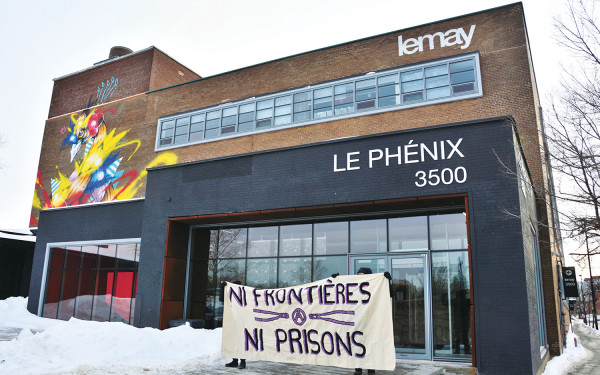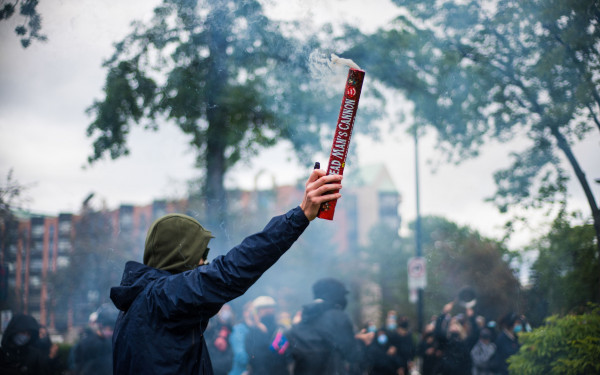Protesters Visit Laval Immigration Detention Centre to Commemorate Lindsay Strikes
Last Saturday, 60 demonstrators protested in front of the Laval immigration detention centre to commemorate last year’s migrant strike in Lindsay, Ont.
On Sept. 17, 2013, 191 immigrant detainees staged a peaceful protest after they were transferred from a Toronto detention centre to the maximum-security prison in Lindsay. A few of them committed to a 60-day hunger strike.
The detainees felt isolated after being relocated more than an hour’s drive away from their families and lawyers.
“These are people who, maybe they had small charges, but most likely they just got picked up and didn’t have papers,” said Virginia Lee, one of the protest organizers. Lee is also part of the Prison Radio Show, which runs Fridays on McGill-based campus station CKUT.
The strikers pointed out faults in Canada’s immigration detention methods, such as arbitrary detention. A working group of the U.N. Commission on Human Rights released a report calling Canada’s system “endless”—some migrants spend a decade in holding centres.
“The report basically says if you can’t deport them, they shouldn’t be in detention,” said Lee. “There isn’t any real way to plead your case and get out.”
The Lindsay strikers also demanded migrant detainees not be held in maximum-security prisons. These prisons offer less access to basic resources like showers, time outside and programs some detainees may need to complete before they can be freed or let out on bail. Migrants also
have limited access to legal aid, including interpreters and pro bono representation.
The march Saturday in the east end of Laval was meant to also raise awareness of other issues linked to Canada’s justice system, including wage cuts felt by inmates working in prison-run factories.
The cuts last year reduced wages by 30 per cent; before that, some inmates made up to $6.90 a day, but most received $3. A group of inmates in Ontario are suing the Canadian government for these cuts in a case that should be heard this fall.
“When the prisoner’s pay scale got set in the first place, room and board was factored into that $6.90 number, which hasn’t changed in over 30 years,” said Lee.
As the protesters shouted these accusations through a sound system set up on the roof of a car, many inmates in one of the minimum-security buildings stood by their windows and waved.
In the yard behind a four-foot chain-link fence, some of them even danced as AC/DC’s “Highway to Hell” blared from the street. A young family stood on the porch of one of the centre’s “weekend homes” to watch the commotion.
“Part of the point of coming all the way out here is to let people know on the inside that we’re doing these protests,” Lee said.
Looking directly into the rooms of one of the minimum-security buildings—guarded by officers in colourful uniforms as part of their own protest against the provincial government’s pension reform legislation—it’s hard to imagine inmates enduring the depraved conditions often depicted on television.
Arash Aslani, an activist and former detainee, was held in the Laval centre for 11 months. He calls it a “human taming centre.”
“We’re not here to say the beds are dirty or the washrooms are not clean,” said Aslani. “My name is Arash, but nobody called me Arash, I was 205 Delta.”
Aslani, who left Iran in 2004, said he felt more like a criminal than a refugee.
“You left your country, you didn’t have a beautiful life in your country,” he said, describing the situation of many migrants in holding centres. “And [guards] talk to you and say, ‘you are not allowed to do that,’ in a patronizing way.”
The visiting room of the immigration detention centre looks a lot like a public school cafeteria. Swivel chairs are bolted to round tables in a plain pink tiled room. While many joke about school being prison, there are fewer tears and hushed conversations in cafeterias.
Carlos Alfredo Gomez is a native El Salvadorian who came to Canada seven year ago. Gomez, his wife, mother-in-law and newborn son crossed the border in 2007 from the United States, where they had been living for two years. After his two-year Canadian visa expired, Gomez continued to live in Canada without papers.
“We came to Canada for a better life, but here it’s worse,” he said in near-perfect French. “For us, who come from Central America, it’s impossible to get papers.”
Now he lives in the Laval holding centre with other illegal immigrants and struggles with family issues. His wife died last year during surgery for a heart infection she couldn’t afford to get treated without health insurance.
And now her aunt, who immigrated legally to Canada during the civil war in El Salvador, is demanding custody of Gomez’s child.
“If I leave my son here, I will lose him completely,” he said. Gomez’s eight-year-old son has U.S. citizenship because he was born there, and has a better chance of staying in Canada than his father.
After spending three months in the Laval detention centre, Gomez was set to be deported this week, but will stay until at least next month for a court hearing on whether he can keep custody of his son.

2_900_599_90.jpg)
_600_832_s.png)

_600_375_90_s_c1.jpg)

_600_375_90_s_c1.jpg)
